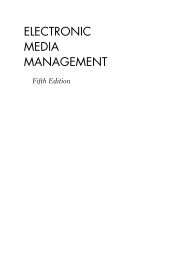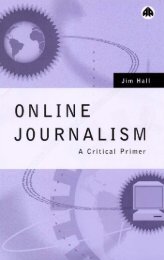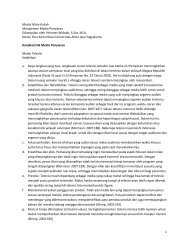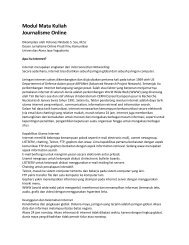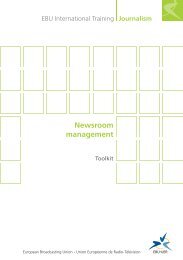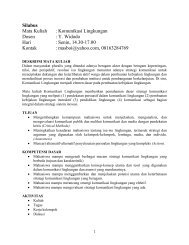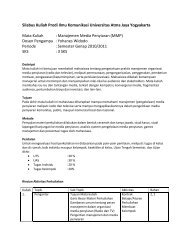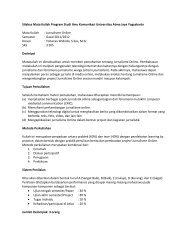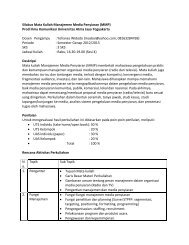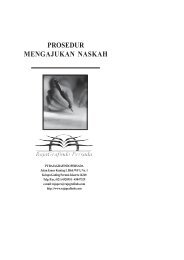1What is online journalism? - Ayo Menulis FISIP UAJY
1What is online journalism? - Ayo Menulis FISIP UAJY
1What is online journalism? - Ayo Menulis FISIP UAJY
Create successful ePaper yourself
Turn your PDF publications into a flip-book with our unique Google optimized e-Paper software.
Design your web resource 189<br />
presenting training information, particularly where it could<br />
be confusing or even dangerous if someone skipped a<br />
section.<br />
2 The grid – th<strong>is</strong> can be useful where you have a lot of information<br />
within a particular field that shares common character<strong>is</strong>tics. For<br />
example, if you were building a site about the Engl<strong>is</strong>h Football<br />
Premiership, you might want to l<strong>is</strong>t each club and then look at<br />
each club’s facilities, player signings, d<strong>is</strong>ciplinary record, etc.<br />
With a grid system, your user could follow each club through all<br />
the club’s pages; or they could cut across the clubs and examine<br />
by category (e.g. look at pages l<strong>is</strong>ting the d<strong>is</strong>ciplinary record of<br />
each club). You can organize the content of grid-structured sites<br />
with a database. Indeed, databases can be used for any part of<br />
your site where you would put large amounts of searchable<br />
information of a similar nature and composition, such as a<br />
catalogue or staff directory. However, as Rosenfeld and Morville<br />
point out, they can be very expensive and time consuming<br />
to construct and will need the input of a programmer. Do not<br />
undertake them lightly.<br />
3 The hierarchy – as already noted, th<strong>is</strong> <strong>is</strong> a common structure<br />
for web sites. Lynch and Horton believe it <strong>is</strong> ‘the best way to<br />
organize most complex bodies of information . . . Hierarchical<br />
diagrams are very familiar in corporate and institutional life,<br />
so most users find th<strong>is</strong> structure easy to understand. A<br />
hierarchical organization also imposes a useful d<strong>is</strong>cipline on<br />
your own analytical approach to your content, because hierarchies<br />
are practical only with well-organized material.’ The<br />
depth or flatness of your hierarchy <strong>is</strong> another <strong>is</strong>sue. If you<br />
have a very flat structure, with one home page leading to a<br />
single secondary level with multiple pages, the menu on your<br />
home page will be extensive, some might say unwieldy and<br />
d<strong>is</strong>couraging. If, instead, you opt for a very deep structure,<br />
with different levels of menu and sub-menus before you arrive<br />
at the content, you r<strong>is</strong>k alienating the user, who may have to<br />
click through too many pages of what are called ‘nested<br />
menus’ to get to what he or she wants. As ever, it <strong>is</strong> a matter<br />
of balance. Interviewed since writing h<strong>is</strong> book, Lou<strong>is</strong> Rosenfeld<br />
says that user preference <strong>is</strong> moving towards the flat



